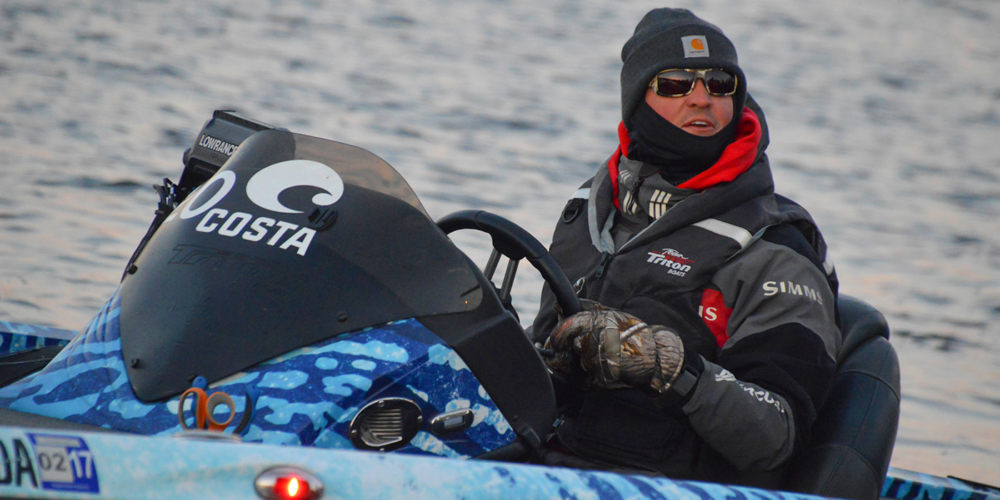Follow Casey Ashley’s Advice for Cold-Water Success on Highland Lakes

Give Casey Ashley a highland reservoir in the middle of winter, and you’ll make him a very happy man. Ashley has won multiple major events fishing during cold weather months on highland fisheries and grew up fishing them in his native South Carolina.
“I’d be happy if we did all of the events in the winter on highland reservoirs,” Ashley admits. “I bet I’d do pretty well.”
When he’s fishing highland reservoirs, Ashley sticks with the basics, no matter if he’s fishing in South Carolina or elsewhere. His first goal: find the bait.
“There’s half the fishing pressure – or less – in the winter, and the fish gang up in tight schools,” Ashley says. “But none of that matters unless you find the bait. I’d say nine out of 10 times, the bait, and then the bass, too, will be located on some ditch, creek channel or roadbed. The bait will slide up and down these structures and up onto the flats. Find the bait, and you’ll find the bass.”
Largemouth and spotted bass are the primary targets Ashley is hunting for on highland lakes. During the winter months, bass tend to be heavier, really healthy, and not far from their summer haunts.
“The bass’ biological clock is ticking during the winter,” Ashley observes. “Bass are definitely heavier and are feeding up for the spawn. Lots of times, they’re located in the same places you fished for them during the summer months, but they tend to be deeper. Because of this, lighter line is in order. Not because they’re line shy, but because the lighter line allows your bait to get to the bottom.”
Ashley’s Cold-Water ‘Go-Tos’
Speaking of baits, Ashley has a few “go-tos” he’s relied on for years to pull bass out of the cold winter water.
“My favorite cold-water bait is an underspin,” Ashley says. “I’ll put a pearl white Zoom Super Fluke Jr. on it and it really works, but the water has to be clear for it to work well. If the water is stained that day, and you’re fishing in 10 feet of water or less, a Shad Rap is hard to beat. That bait has won a lot of tournaments in South Carolina when the water temperatures are in the 50s or cooler.”
Ashley suggests a specific rod and reel set up to fish the underspin properly.
“I go with a 7-foot medium action Quantum Smoke inshore rod paired with a Vapor 6.3:1 reel loaded with 10-pound fluorocarbon line,” he says. “That combo allows me to make long casts and the reel’s retrieve ratio allows me to use a steady, slow retrieve that keeps the bait down deeper. The rod is just the right action to allow the fish to take the lure and get a proper hookset. It’s a must-have to fish this lure properly in my opinion.”
The underspin and Shad Rap aren’t the only two options he uses during the cold weather.
“I also have a shaky head jig rigged with a Zoom Finesse worm and a spoon,” Ashley says. “I really like the Kudzu color. It mimics the color of crayfish in the winter months. Also, rootbeer pepper is another very good choice in cold water, any temperature in the 50s or colder. The spoon I like to use is made locally, a Berry spoon. It’s especially effective in water 20 feet or deeper. It’s fished for reaction strikes. I’ll give it a hard jerk up and let it flutter down.
“The spoon is flat, painted, and taped. It looks like nothing special, but the bass absolutely kill it when the water is in the high 40s.”
Ashley has one last piece of advice when you venture out in search of wintertime bass on highland reservoirs.
“Be patient,” he says. “It doesn’t matter if you’re fishing Lake Hartwell, any of the Savannah River Chain lakes here in South Carolina, Lay Lake and Logan Martin in Alabama, or any other highland reservoir. Patience is so important. Remember, bass form big schools in the winter, but they can be in very small areas, sometimes no bigger than your boat. But, once you find them, you can catch them one after the other.”